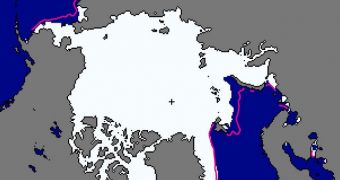The latest report from the US National Snow and Ice Data Center (NSIDC) indicates that Arctic sea ice extents remained below average for December 2013, marking the fourth-lowest extent registered in the satellite record. However, levels recorded last month were higher than those seen in 2012.
Fortunately, the missing ices at the South Pole were counterbalanced by ice growth at the South Pole. The entire continent of Antarctica was a lot more difficult to access throughout this winter, as evidenced by the recent incident where a Russian ship became entangled in Antarctic sea ices.
According to the NSIDC, the total sea ice in the Arctic covered a total of 12.38 million square kilometers (4.78 million square miles), which is around 700,000 kilometers (270,300 square miles) below the 36-year satellite record (1981-2010). This is the fourth-lowest extent in the record.
Throughout December, a total of 1.85 million square kilometers (714,000 square miles) of sea ice formed in the Arctic, a value considerably smaller than the long-term average. Scientists recorded periods of very slow growth, and also periods where extents retreated due to massive storms.
The Greenland Sea and Baffin Bay were the areas where sea ice extent was the closest to long-term values. In the Bering Sea and Sea of Okhotsk (on the Pacific side of the Arctic), and in the Barents Sea on the Atlantic sector, sea ice extents for December were well below average.
“Ice grew at rates slower than average through most of December, at 59,500 square kilometers per day (23,000 square miles per day) compared to the 1981 to 2010 average of 62,400 square kilometers per day (24,100 square miles per day),” the report indicates.
“At the end of the month the extent was 750,000 square kilometers (289,600 square miles) below the 1981 to 2010 average and nearly identical to the extent at the end of 2012,” the document reveals.
Temperatures at an altitude of 914 meters (3,000 feet) were above average for this time of the year. Areas over eastern Siberia were the worst affected, experiencing temperatures up to 6 degrees Celsius, or 11 degrees Fahrenheit, above normal values.
“Over the central Arctic Ocean, temperatures were 2 to 5 degrees Celsius (4 to 9 ºF) above average. By sharp contrast, relatively cool conditions prevailed over northern North America. Temperatures in areas such as the Yukon Territory were 6 degrees Celsius (10 ºF) or more below average,” the report states.

 14 DAY TRIAL //
14 DAY TRIAL //